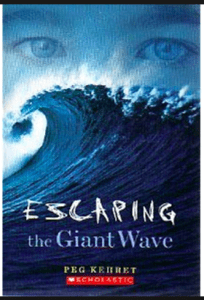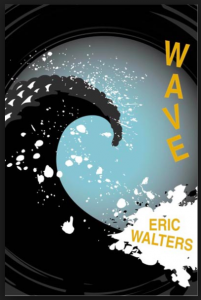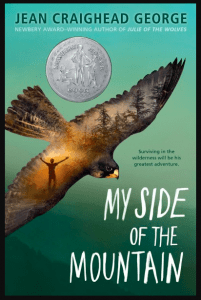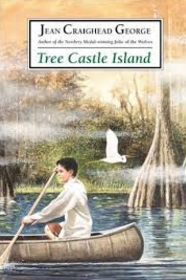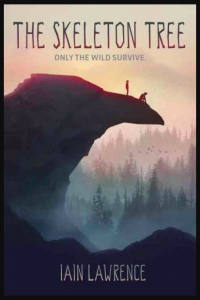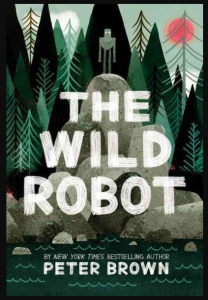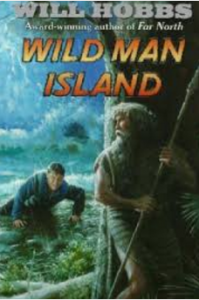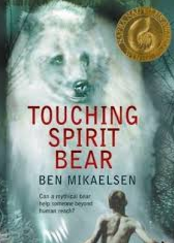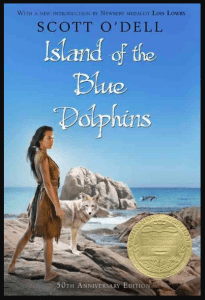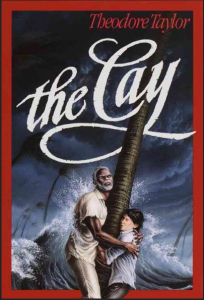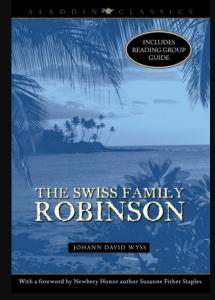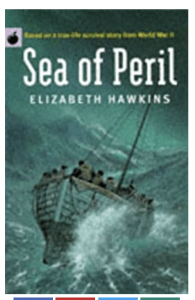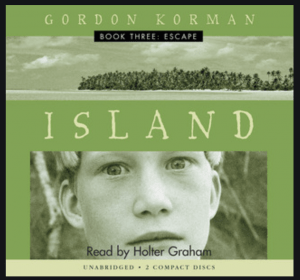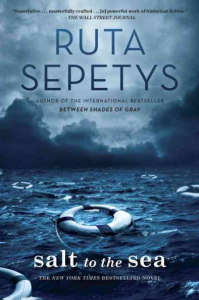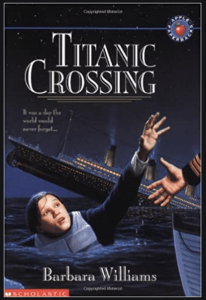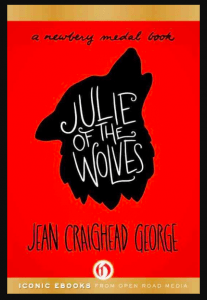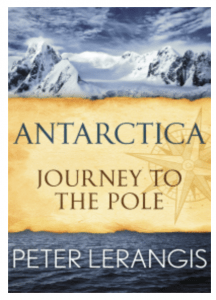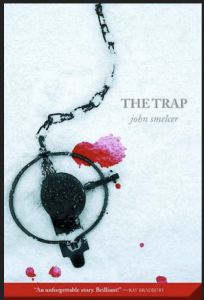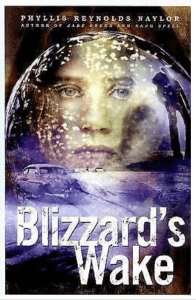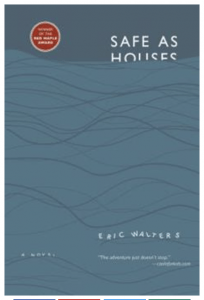Realistic Novels of Extreme Environments
Earthquakes and Tsunamis
Kehret, Peg. Escaping the Giant Wave. New York: Aladdin, 2003.
When an earthquake creates a tsunami while thirteen-year-old Kyle is babysitting his sister during a family vacation at a Pacific Coast resort, he tries to save himself, his sister, and a boy who has bullied him for years. (FVRL)
Kling, Heidi R. Sea. New York: G.P. Putnam’s Sons, 2010.
Despite recurring nightmares about her mother’s death and her own fear of flying, fifteen-year-old Sienna accepts her father’s birthday gift to fly to Indonesia with his team of disaster relief workers to help victims of a recent tsunami, never suspecting that this experience will change her life forever. (CIP) [Tsunamis; Orphans; Indonesia; Natural disasters; Grief; Love]
Mikaelsen, Ben. Jungle of Bones. New York: Scholastic Press, 2014.
After joyriding in a stolen car, Dylan ends up in Papua New Guinea because his mother sends him to spend the summer with his uncle, an ex-Marine, who is on an expedition to find his grandfather’s bomber which was shot down in World War 2. Resentful, Dylan disregards warnings and gets lost in the jungle. Will he survive? Will he give up his perpetually defiant attitude? This quickly-paced novel will appeal to 11 to 15 year old readers. [Adventure and adventurers; Juvenile delinquents; Papua New Guinea; Survival; Uncles; World War 2]
Walters, Eric. Wave. Doubleday Canada, 2009.
When the 2004 tsunami strikes Thailand, Sam struggles to survive while his sister, Beth, at home in New York City wonders if she will ever see her brother and parents again. Told from alternating points of view, this historically based novel is by a popular and prolific Canadian author.
Forests, Jungles and Wilderness Areas
Budbill, David. Snowshoe Trek to Otter River. Toronto: Bantam, 1976.
Three short stories relate the adventures of twelve-year-old Daniel and his friend Seth while camping in the woods alone and together. (OhoLINK)
Eckert, Allan W. Incident at Hawk’s Hill. New York: Little, Brown and Co., 1971.
..one June day in 1870, Ben wandered away from his home on Hawk’s Hill and disappeared without a trace into the waving prairie grass. How this shy, lonely boy survived most of a summer in the wilds by forging a bond with a female badger is a poignant story of human courage and change. (back cover)
George, Jean Craighead. My Side of the Mountain. New York: Scholastic, 1988.
Sam Gribley is tired of living in a crowded New York City apartment, so he runs away to the Catskill Mountain wilderness to forge a life of his own. With only a penknife, a ball of cord, an ax, $40, and some flint and steel, he must rely on his ingenuity and on the resources of the land to survive. (back cover)
George, Jean Craighead. Tree Castle Island. New York: Scholastic, 2002.
After building his own canoe, fourteen-year-old Jack Hawkins tries it out in his beloved Okefenokee Swamp, where an accident tests his survival skills and leads him to a shocking discovery. (OhioLINK)
Greenslade, Frances. Red Fox Road. Toronto: Puffin Canada, 2020.
Thirteen-year-old Francie and her parents are on a road trip, travelling from B.C. to Arizona. They are supposed to be having fun, but her parents can’t stop arguing. Her mother wants to use a road map; her father insists on using a GPS. He turns onto an old logging road and in the middle of the wilderness of the Pacific Northwest, their truck hits a rock. They’re stuck. Francie’s father is sure he can walk out and get help. Francie and her mother are left to wait, day after day, wait. Finally, Francie’s mother sets off for help, walking in the opposite direction. Francie is now completely alone. Will she be able to survive? This gripping story of survival is sure to appeal to readers who enjoy suspense novels.
Hobbs, Will. Far North. New York: Avon, 1996.After the destruction of their floatplane, sixteen-year-old Gabe and his Dene friend, Raymond, struggle to survive a winter in the wilderness of the Northwest Territories. (NVPL)
Jones, David. Baboon.
Fourteen-year-old Gerry is flying back to his parents’ research camp in Africa when his plane crashes and he has to survive by living with a troop of baboons.
Kehret, Peg. The Secret Journey. New York: Minstrel Books, 1999.
In 1834 when a storm at sea destroys the slave ship on which she is a stowaway, twelve-year-old Emma musters all her resourcefulness to survive in the African jungle. (NVPL)
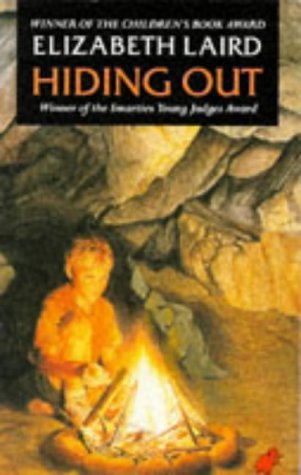
Laird, Elizabeth. Hiding Out.
Peter is accidentally left behind in France when his family returns to England and has to find a way to get home on his own.
Lawrence, Iain. The Skeleton Tree. Toronto: Tundra Books, 2016.
Twelve-year-old Chris and fifteen-year-old Frank, two recently bereaved boys from Vancouver, struggle to survive in the wilderness after their sailboat capsizes off the coast of Alaska. They also struggle to get along with each other. This 278-page novel full of descriptive details – and a bit of the supernatural – will appeal to competent readers 11 to 15 years old who enjoy realistic stories. An afterward provides background information about the author’s experiences in the Pacific Northwest. [Alaska; Fathers and sons; Survival; Ravens; Wilderness areas]
Mikaelsen, Ben. Jungle of Bones. New York: Scholastic Press, 2014.
After joyriding in a stolen car, Dylan ends up in Papua New Guinea because his mother sends him to spend the summer with his uncle, an ex-Marine, who is on an expedition to find his grandfather’s bomber which was shot down in World War 2. Resentful, Dylan disregards warnings and gets lost in the jungle. Will he survive? Will he give up his perpetually defiant attitude? This quickly-paced novel will appeal to 11 to 15 year old readers. [Adventure and adventurers; Juvenile delinquents; Papua New Guinea; Survival; Uncles; World War 2]
Mowat, Farley. Lost in the Barrens. New York: Bantam, 1982.
Stranded in the wilderness, two boys face a challenge most men could not endure. With no food & little hope of rescue, they build a cabin, battle a grizzly, slaughter caribou for food & clothing. Two lost huskies offer companionship & maybe a way to get home. (VPL)
Paulsen, Gary. Brian’s Winter. New York : Scholastic, 1996.
Instead of being rescued from a plane crash, as in the author’s book Hatchet, this story portrays what would have happened to Brian had he been forced to survive a winter in the wilderness with only his survival pack and hatchet. (NVPL)
Paulsen, Gary. Hatchet. Toronto: Scholastic, 1987.
After a plane crash, thirteen-year-old Brian spends fifty-four days in the wilderness, learning to survive initially with only the aid of a hatchet given him by his mother, and learning also to survive his parents’ divorce.
Paulsen, Gary. The River. New York: Dell, 1991.
Because of his success surviving alone in the wilderness for fifty-four days, fifteen-year-old Brian, profoundly changed by his time in the wild, is asked to undergo a similar experience to help scientists learn more about the psychology of survival. Sequel to “Hatchet.”
Rundell, Katherine. The Explorer. New York: Simon & Schuster Books for Young Readers, 2017.
Fred, Con, Lila and Max were supposed to be flying from Brazil to England. But their plane has crashed into the Amazon rainforest. They’re all alone. Except for the snakes and the monkeys and the caimans. Except for an explorer hiding in a ruined city deep within the jungle. More fast-paced than Journey to the River Sea by Eva Ibbotson and more fantastical than Hatchet by Gary Paulsen, this wildly adventurous tale will appeal to readers 10 to 14 years old looking for a new survival story. [All of Katherine Rundell’s novels are full of mysterious events. If you like stories that mix the possibly-real with the truly-real, read more of her stories. Then, if you are at least 12 years old, try novels by Carlos Ruiz Zafón.] [Aircraft accidents; Amazon River Region; Brazil; Explorers; Rainforests; Survival]
Islands
Brown, Peter. The Wild Robot. New York: Little, Brown and Company, 2016.
Roz awakens on a isolated island. Where is she? How did she come to be here? How will she survive? How will she get along with the inhabitants? This marvellous tale about a robot is really about all of us. Why are we on this earth? How can we live together in peace? What does it mean to be human? An excellent read-aloud for grades 4 to 6. A quickly-paced novel for readers 10 to 14 years old.
Defoe, Daniel. The Life and Adventures of Robinson Crusoe. London: UK Puffin Books, 1986.
The life and strange surprizing adventures of Robinson Crusoe, of York, Mariner : who lived eight and twenty years, all alone in an un-inhabited island on the coast of America… (the book)
Hobbs, Will. Wild Man Island. New York: HarperCollins, 2002.
After fourteen-year-old Andy slips away from his kayaking group to visit the wilderness site of his archaeologist father’s death, a storm strands him on Admiralty Island, Alaska, where he manages to survive, encounters unexpected animal and human inhabitants, and looks for traces of the earliest prehistoric immigrants to America. (WAFMS)
Mikaelsen, Ben. Touching Spirit Bear. New York: HarperCollins, 2001.
After his anger erupts into violence, Cole, in order to avoid going to prison, agrees to participate in a sentencing alternative based on the native American Circle Justice, and he is sent to a remote Alaskan Island where an encounter with a huge Spirit Bear changes his life. (WAFMS)
Touching Spirit Bear is a phenomenal book … about a young boy who has a troubled life at home, with his alcoholic parents, and at school where he has a reputation for being an extremely physical bully. At age fifteen, Cole Mathews has done his worst crime yet; he has beat up an innocent kid and now has to make a choice: jail or Circle Justice for one year in total isolation. Cole chooses Circle Justice where he destroys his shelter and attempts an attack on a massive crystal white Spirit Bear; in a flash he is lying on the floor, unconscious for two days. Learning that being ‘invisible’ is the only way to see his enemy again, Cole becomes calmer and tries to help the boy who he nearly killed. Can Cole help this helpless boy? Will anyone ever forgive him? Read this touching book to find out! (Jordyn in grade eight)
O’Dell, Scott. Island of the Blue Dolphins. New York: Dell, 1960.
This is the story of Karana, the Indian girl who lived alone for years on the Island of the Blue Dolphins. . . . based on the fact that in the early 1800’s an Indian girl spent 18 years alone on a rocky island far off the coast of California. (back cover)
Orr, Wendy. Nim’s Island. New York: Dell Yearling, 2002.
Nim loves her island home and the animals she shares it with even while her scientist father is away doing research, but trouble is on the way and a new e-mail friend could be the only one who can help. (OhioLINK)
Taylor, Theodore. The Cay. New York: Dell, 2002.
When the freighter on which they are traveling is torpedoed by a German submarine during World War II, a twelve-year-old white boy, blinded by a blow on the head, and an old Negro are stranded on a small desert island in the Caribbean where the boy acquires a new kind of vision, courage, and love from his old companion. (OhioLink)
Wyss, Johann David. The Swiss Family Robinson. Toronto: Scholastic, 1991.
When a Swiss couple and their four sons are shipwrecked on an isolated island, they adapt to their “New Switzerland” using many imaginative methods of farming and animal taming. (OhioLINK)
Mountains
Korman, Gordon. The Climb. Toronto: Scholastic, 2002.
Four kids are prepared to go into thin air in order to become the youngest person ever to climb Everest. But they are not prepared for the challenges that await them as they get closer to the summit. (OhioLINK) This is the second in a series. The first is ‘The Contest’ and the third is ‘The Summit’.
Oceans and Seas
Hawkins, Elizabeth. Sea of Peril. London: Orchard Books. 1995.
Based on a true-life survival story from World War II. Jimmy, Sidney and the other children were on their way to Canada, evacuees from the bombed cities of Britain in 1940. Life on board a luxury liner should have been an exciting adventure….Now they were adrift, lost in an ice-cold sea….(back cover)
Korman, Gordon. The Danger. New York: Scholastic, 2003.
Four kids discover treasure at the bottom of the sea and try to remove it from the sunken ship it’s in. (OhioLINK) This is the second in a series set in the Caribbean. The first is ‘The Discovery’ and the third is ‘The Deep’.
Korman, Gordon. Escape. New York: Scholastic, 2001.
They didn’t want to be on the boat in the first place. They didn’t want to be stuck at sea with a bunch of strangers. But when a terrifying storm hits, what they want doesn’t matter. It’s all about survival.(NVPL) This is the third in the series.
Korman, Gordon. Shipwreck. Toronto: Scholastic, 2001.
Six kids…are thrown together against their will on a small boat that will make a one-month journey on the Pacific Ocean…[and] have to learn to work together to survive a vicious storm and a shipwreck that leave them stranded in the middle of the ocean with no food, no water, and almost no hope for survival. (OhioLINK) This is the first in the series.
Paulsen, Gary. The Voyage of the Frog. New York: Dell, 1989.
When David goes out on his sailboat to scatter his recently deceased uncle’s ashes to the wind, he is caught in a fierce storm and must survive many days on his own as he works out his feelings about life and his uncle.
Sepetys, Ruta. Salt to the Sea. New York: Philomel Books, 2016.
Fleeing the invading Russian army near the end of the war, refugees try to escape aboard a military transport ship transporting German evacuees. Told from alternating points of view and based on the true story of the Wilhelm Gustloff, this award-winning 389-page emotion-laden novel is highly recommended for mature readers 13 years old and up. Includes a map. [Germany; Historical fiction; Poland; Refugees; Survival; WW 2; Young adult fiction]
Skrypuch, Marsha Forchuk with Tuan Ho. Adrift At Sea: A Vietnamese Boy’s Story of Survival. Toronto: Pajama Press, 2016.
In 1981, six-year-old Tuan escaped with his mother and two of his sisters. In the middle of the night, they got on a boat which took them far out to sea where they were rescued by sailors on an American aircraft carrier. Illustrated by award-winning Brian Deines, this powerful picture book tells the true story of one child’s journey as a refugee from Vietnam to Canada. Accompanied by historical and biographical information, as well as numerous photographs, this informative and inspiring story is recommended for readers 8 years old and up.
Tullson, Diane. Red Sea. Victoria: Orca, 2005.
Fourteen-year-old Libby didn’t want to go on a yearlong sailing adventure with her mother and her stepfather, Duncan, and she isn’t about to let them forget it. When modern-day pirates attack, Duncan is killed and Libby’s mother is left seriously injured and unconscious. Libby is left alone on a crippled boat to find safety and help for her mother. (back cover)
Williams, Barbara. Titanic Crossing. Toronto: Scholastic, 1995.
It was a ship bigger and better than anything the world had ever seen. Albert had been reading about the ocean liner while he was staying in England. And now he had the once-in-a-lifetime chance to sail… (back cover)
Polar Regions
George, Jean Craighead. Julie. New York: Harper, 1994.
When Julie returns to her father’s Eskimo village, she struggles to find a way to save her beloved wolves in a changing Arctic world and she falls in love with a young Siberian man. Sequel to ‘Julie of the Wolves’ (OhioLINK)
George, Jean Craighead. Julie of the Wolves. New York: Scholastic, 1972.
While running away from home and an unwanted marriage, a thirteen-year-old Eskimo girl becomes lost on the North Slope of Alaska and is befriended by a wolf pack. (NVPL)
Hill, Kirkpatrick. Winter Camp. New York: Puffin Books, 1993.
Eleven-year-old Toughboy and his younger sister must survive the harsh Alaskan winter at a friend’s winter trapping camp after their parents die. (WAFMS)
Hobbs, Will. Far North.
Sixteen-year-old Gabe and his friend Raymond survive a winter in the wilderness of the Northwest Territories after their floatplane is destroyed.
Houston, James. Frozen North. Toronto: McClelland & Stewart, 1991.
After a plane crash, thirteen-year-old Brian spends fifty-four days in the wilderness, learning to survive initially with only the aid of a hatchet given him by his mother, and learning also to survive his parents’ divorce. (NVPL)
Lerangis, Peter. Antarctica: Journey to the Pole. New York: Scholastic, 2000.
Smelcer, John. The Trap. New York: NY Square Fish, 2006.
In alternating chapters, seventeen-year-old Johnny Least-Weasel, who is better known for brains than brawn, worries about his missing grandfather, and the grandfather, Albert Least-Weasel, struggles to survive, caught in his own steel trap in the Alaskan winter. (NVPL)
Weather Extremes
Naylor, Phyllis Reynolds. Blizzard’s Wake. Toronto: Scholastic, 2002.
In March of 1941, when a severe blizzard suddenly hits Bismarck, North Dakota, a girl trying to save her stranded father and brother inadvertently helps the man who killed her mother four years before. (WAFMS)
Peterson, P.J. Rising Water. New York: Simon & Schuster, 2002.
When Tracy, her brother, and the new animal care volunteer at the Jefferson Science Center travel by boat to feed a dog stranded by flooding, their dangerous adventures give them new perspectives on themselves and on each other. (WAFMS)
Walters, Eric. Safe as Houses. N.p.: Seal Books, 2007.
On October 15, 1954, babysitter Lizzie Hardy was walking David and Suzie McBride home from school, as she did every weekday. When Hurricane Hazel hit, the three children had to try and survive on their own. (NVPL)
Your Responses and Reviews!
The Cay by Theodore Taylor (Yearling Books, 1969) is the story of Philip who gets separated from his mom at sea. Philip, who is now blind, faces a conflict: he must trust a black man named Timothy. Because he is blind and would be helpless without Timothy, he learns to use his senses instead of seeing. He ends up being rescued and going back to his hometown. A doctor helps him so he can see again. I like how Philip ends up trusting a black man. I thought this was one of the better books I have ever read. (Callum in grade eight)
I have recently finished a book called The Killing Sea by Richard Lewis (Simon and Schuster, 2006) about a boy named Ruslan who gets split apart from his family when a tsunami hits Aceh, Indonesia. This book tells you about a true natural disaster and puts a human in a terrible tragedy. Ruslan is searching for his missing father while an American girl named Sarah is searching for help for her sick brother. Together Ruslan and Sarah embark on a true journey to find and help their loved ones. Soon enough, Ruslan finds his father but unfortunately for Sarah, her mother was killed in all of the madness, although she finds her father just in time to get her brother admitted to a hospital. As the story progresses, the destruction gets worse and worse. Ruslan is struggling to find his home and hopefully some of his friends and neighbours. By the end of this thrilling story, Ruslan and Sarah have become very good friends and Sarah and her family stay in Indonesia to help clean up what has happened on that terrible day. (MacKenzie in grade six)
Treasure Island by Robert Louis Stevenson (Usborne Publishing, 2006) is about a rather quiet and peaceful boy named Jim whose family owns a small inn. After his father catches a deadly illness and begins to die, pirates attack the inn, looking for a map to Flint’s treasure. Jim escapes with the map and ends up on a ship where he faces a dilemma: remain loyal to the captain or join the crew of stowaway pirates. In the end, Jim takes the ship while the pirates are on an island and leaves with the captain and all the loyal crewmates. Jim rears his head in victory because he steals the treasure, as well. (Caleb in grade eight)
Island of the Blue Dolphins by Scott O’Dell (Yearling, 1960) is a book I enjoyed. It starts in the summer on a deserted island that is shaped like a big fish. The main character, a girl named Karana, is the daughter of the Indian chief, and they live on the Pacific island with their tribe, living off the land in the middle of nowhere. They make their own shelters, sew their own clothing and gather their own food. One day, an Indian named Kimki canoed to a new place to explore. When he got to land, he thought it would be a great place to live. He told the people there about the tribe on the island and he asked them to go back and get his tribe from the island. When the boat came for the tribe, they all boarded. However when they were leaving, Karana noticed that her little brother, Ramo, was not on the boat. Her father, the chief, said they’d come back another day for him because there was a storm coming and they couldn’t wait any longer. Therefore, Karana quickly jumped off the boat and swam to shore, so her brother wouldn’t be alone. How long will the two have to wait for someone to come back for them? Karana must take charge and build a shelter to survive the storms. She must get food and make weapons to fight the wild dogs. What will happen to Karana and her brother? Will the boats come back? How will this story end?
This novel is a Newbery medal winner and will appeal to both boys and girls in grades six and up. (by Megan in grade eight)
When I’m reading a book I really like, I feel like I’m in the story with the characters, as if I’m going through all the things they are going through and feeling all the emotions. That’s how I know I’m reading a good book. The book Journey to the River Sea by Eva Ibbotson (Macmillan Children’s Books, 2001) made me feel like I was in the story. It is about Maia, a teen girl who has moved from a girls’ boarding school in England to the only family she has left: her aunt, uncle and two cousins who live in the middle of the Amazon rainforest. She and her governess, Miss Minton, go through many trials together. Maia’s twin cousins are rude and conceited, and her aunt and uncle only care about the money Maia is bringing with her. Fortunately, Maia makes many friends including the Indian servants and the few European children who live in the jungle. One person Maia grows very close to is a boy named Finn Taverner whose European father and Indian mother have died. He has no family left except an uncle who wants Finn to come to England to inherit the fortune and the estate of the Taverner family. Everything works out in the end, but the journey is one that I will never forget! (Luisa in grade eight)
In Escaping The Giant Wave, by Peg Kehret (2004), twelve-year-old Kyle Davidson is babysitting his eight-year-old sister while on vacation on the Oregon coast when a huge earthquake hits and the hotel catches fire; Kyle manages to get himself and his sister out of the fire and goes upland away from three giant tsunamis that hit land; I think Escaping the Giant Wave is a great novel! (Cassandra in gr. 6)
